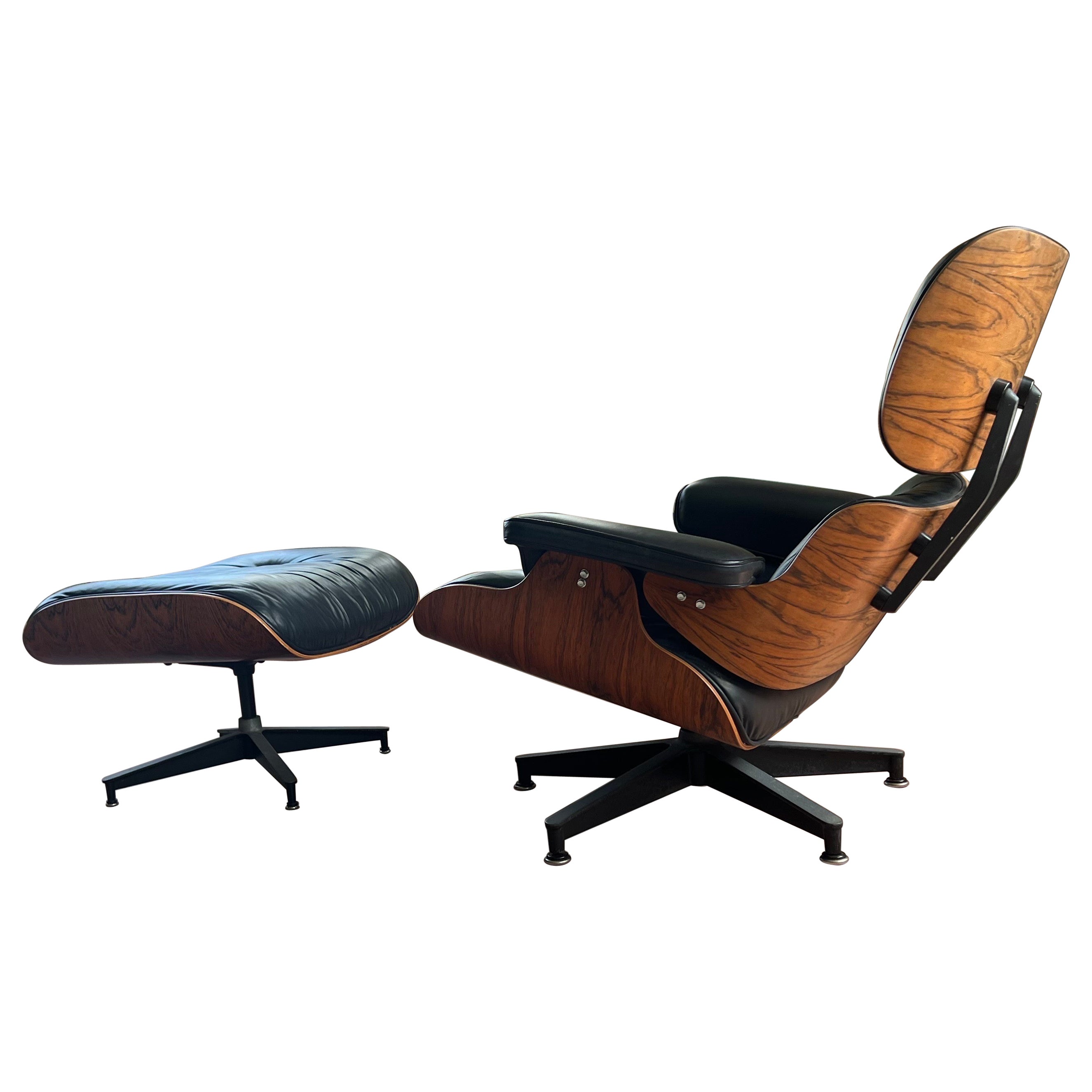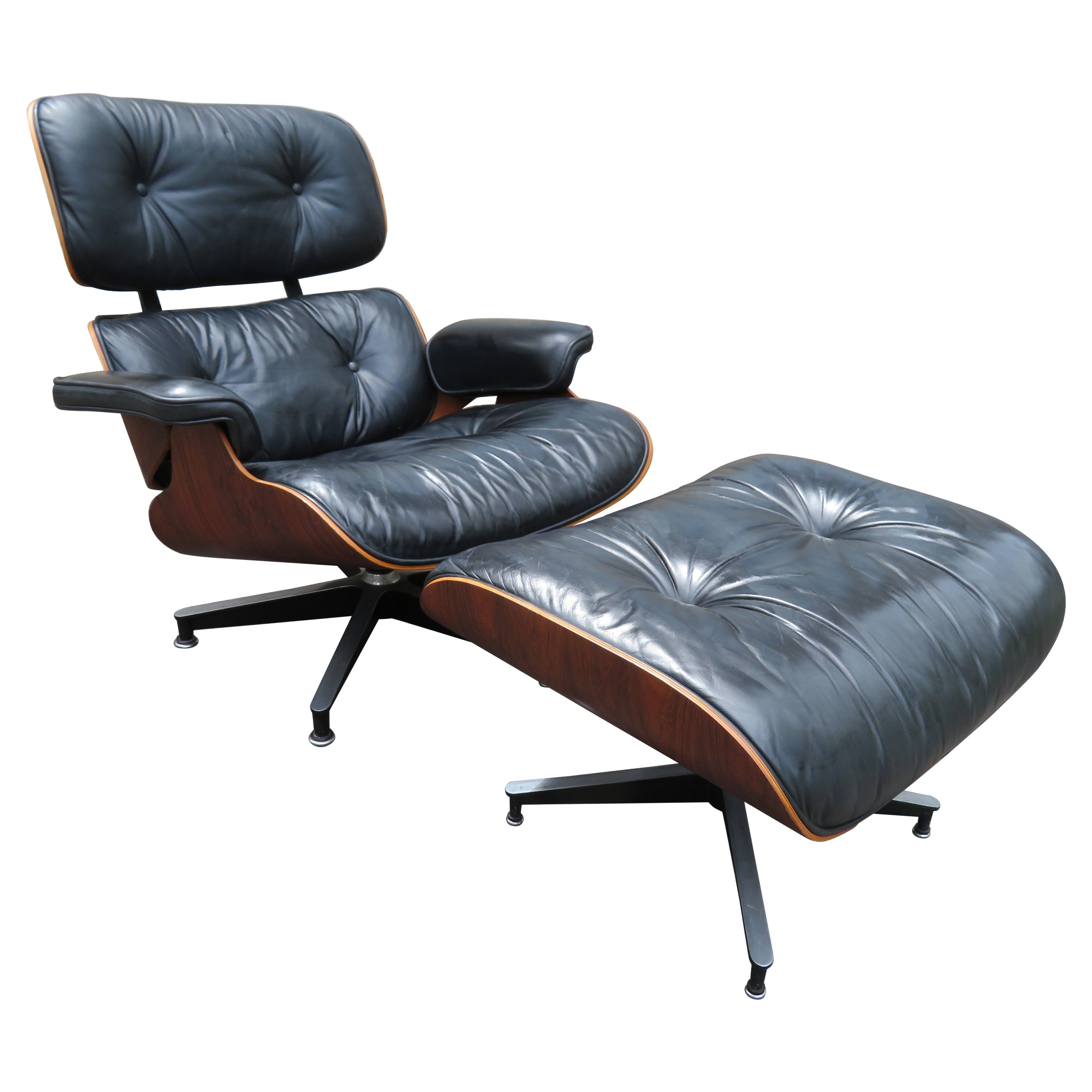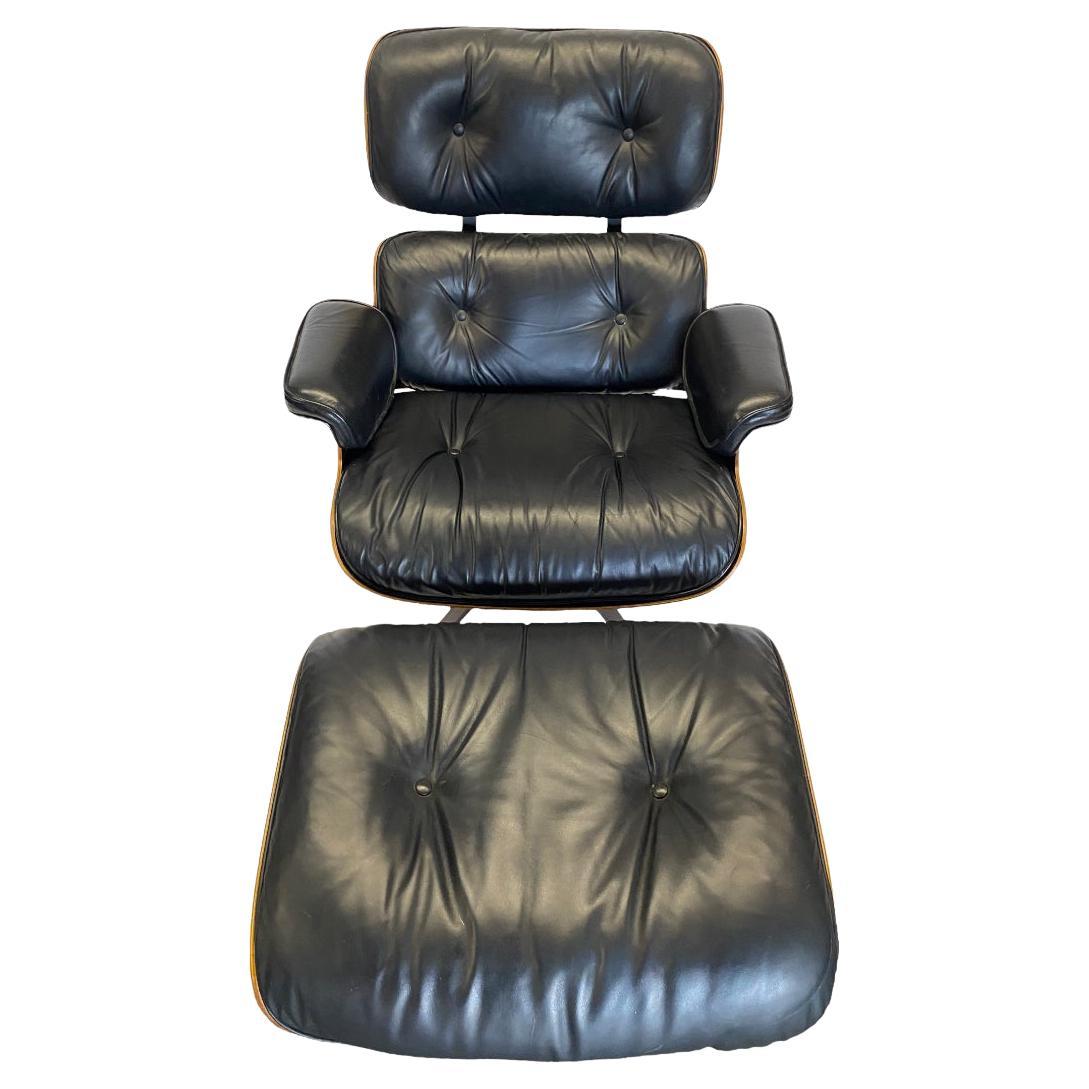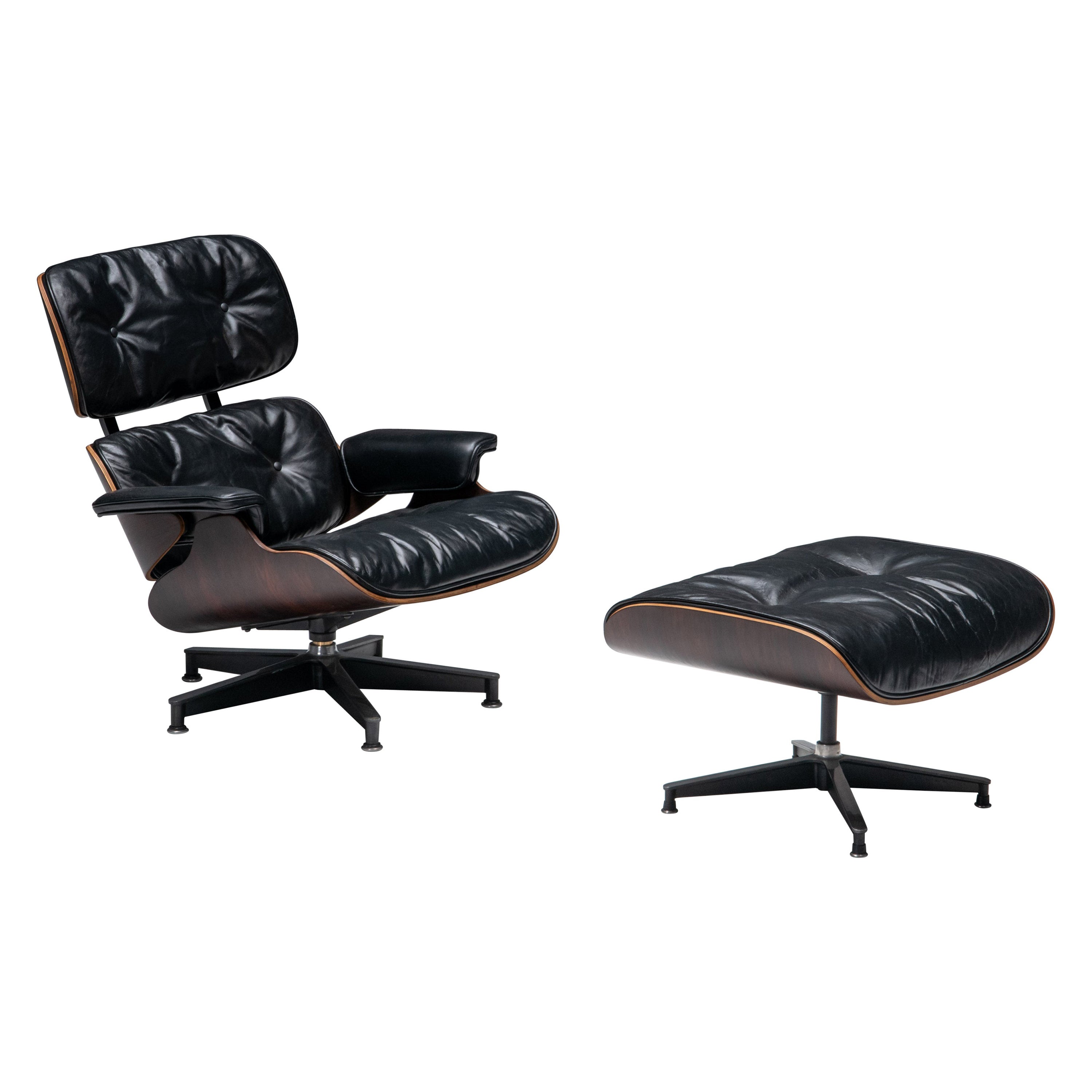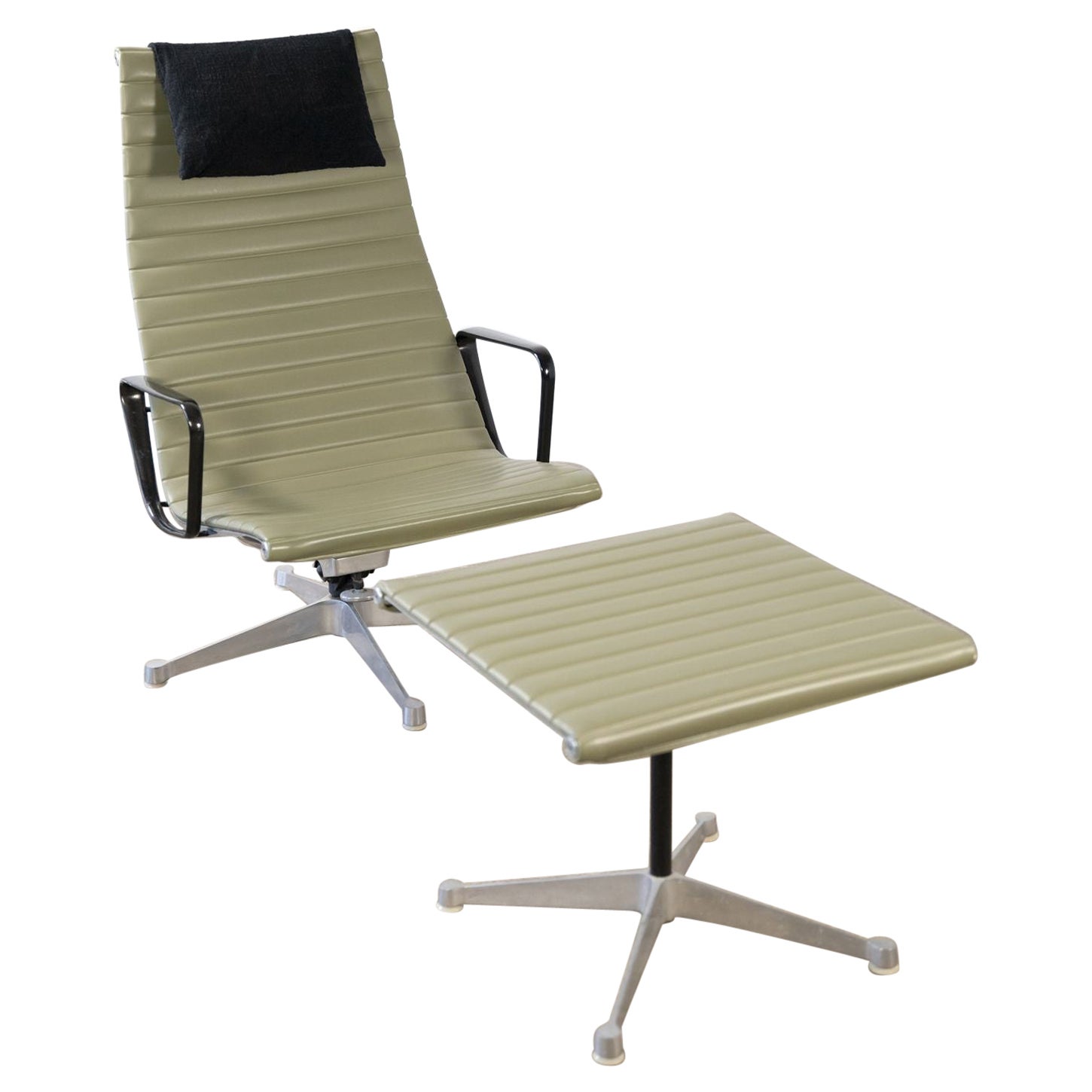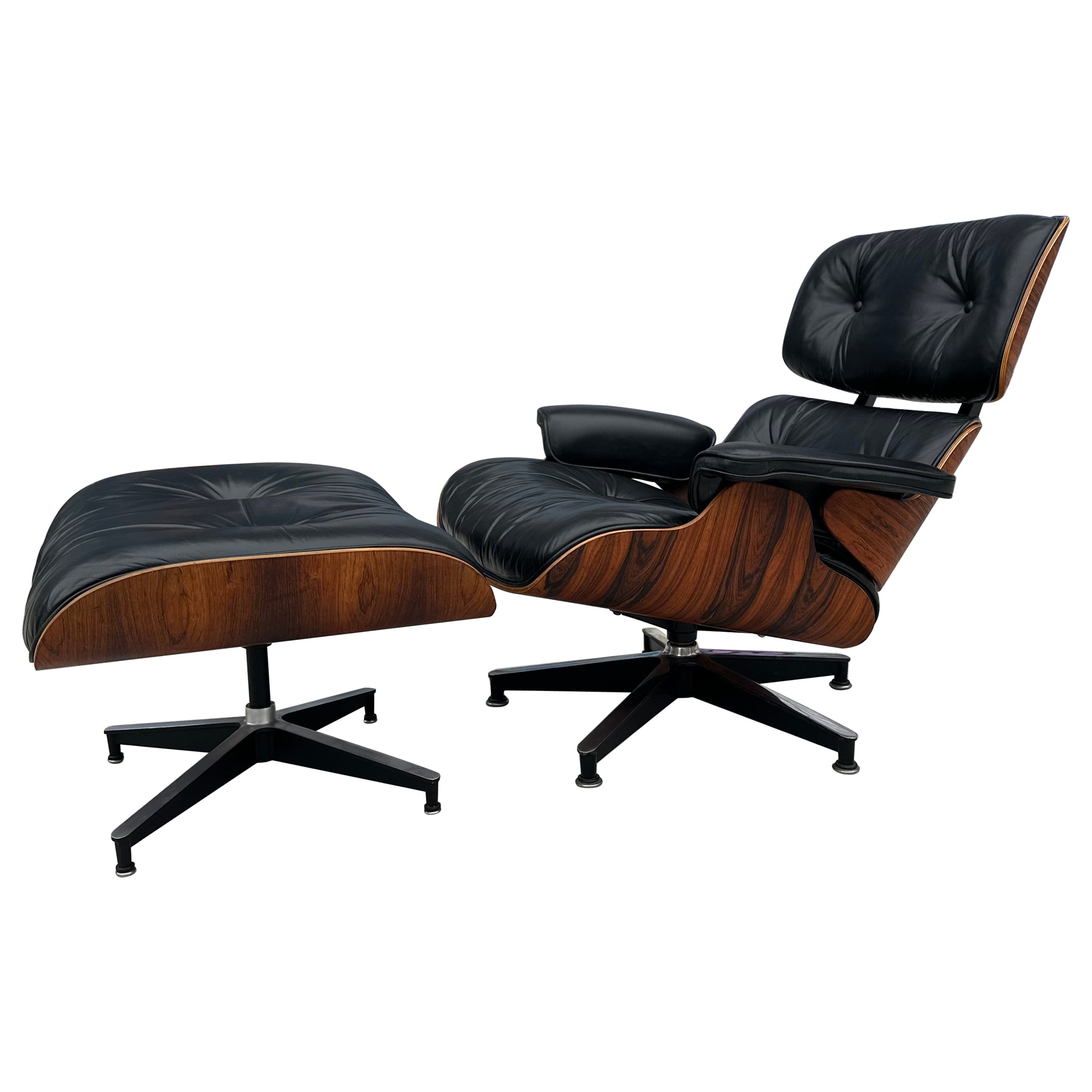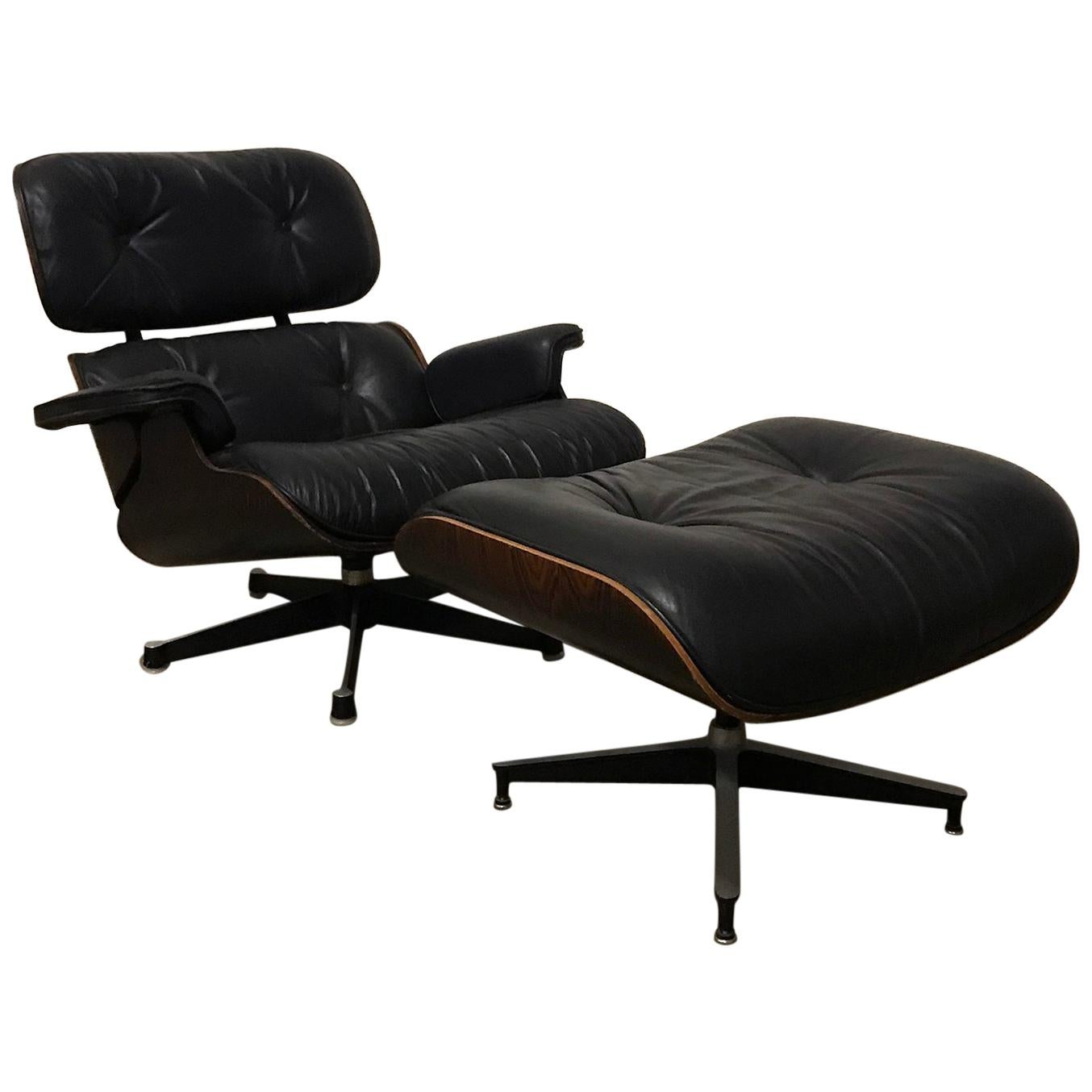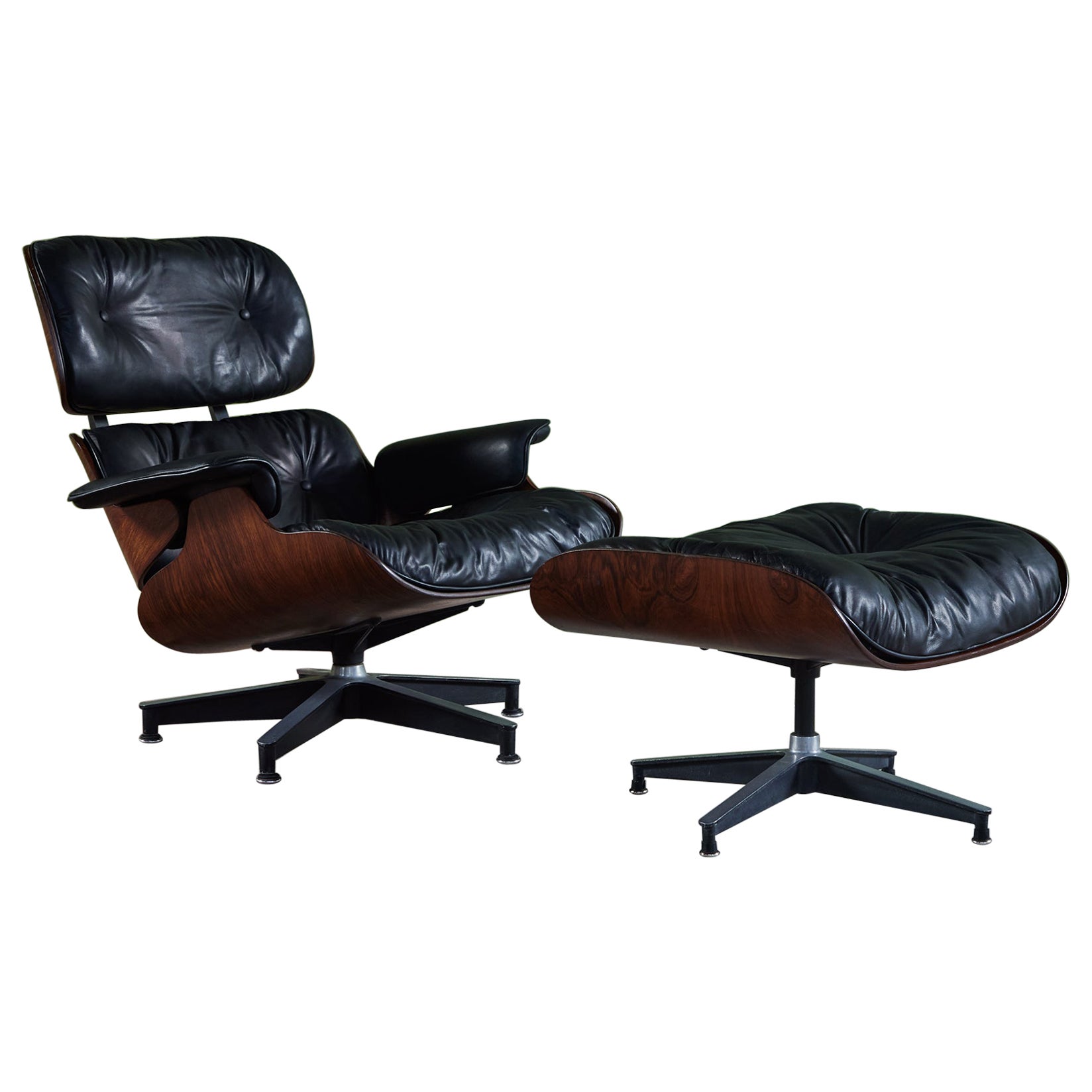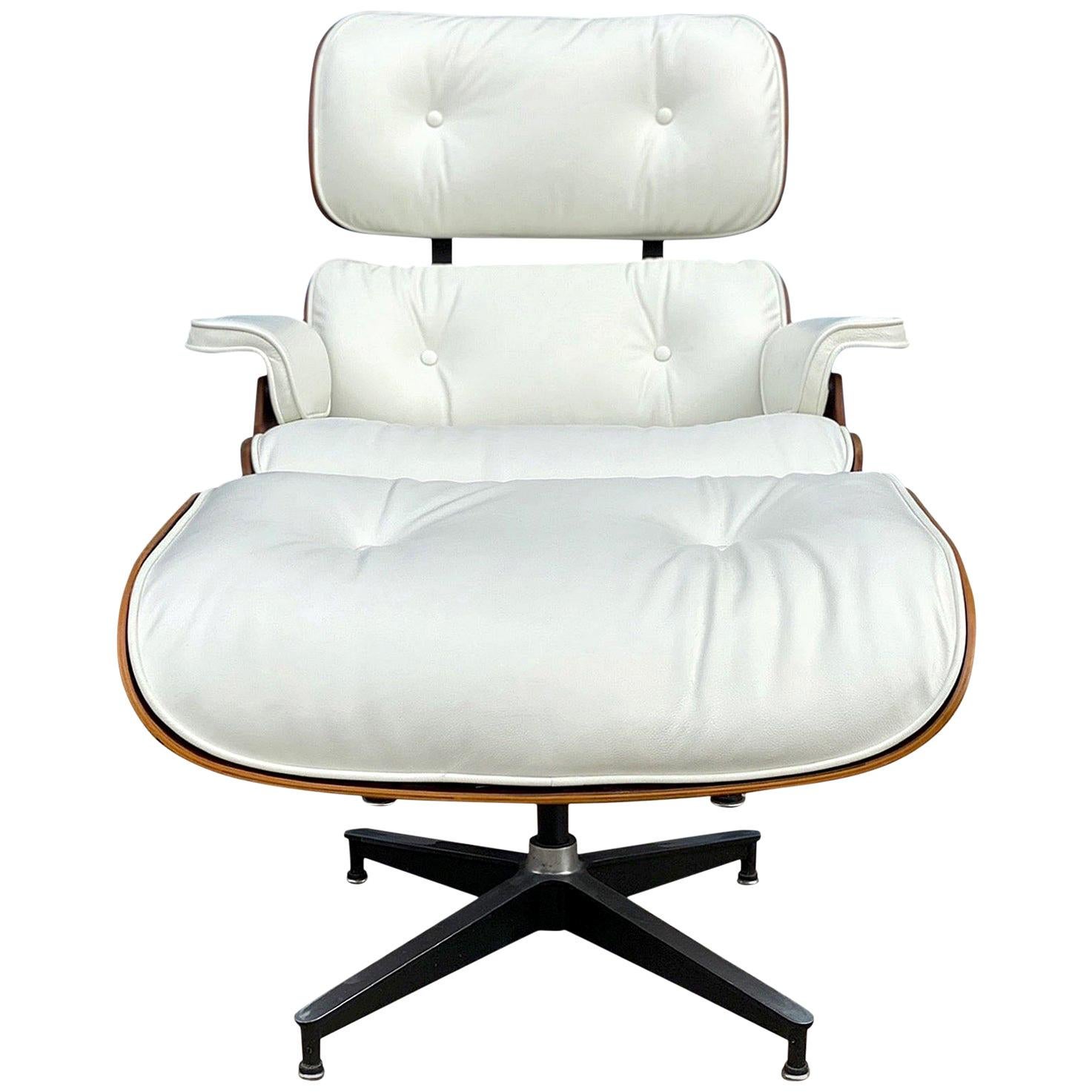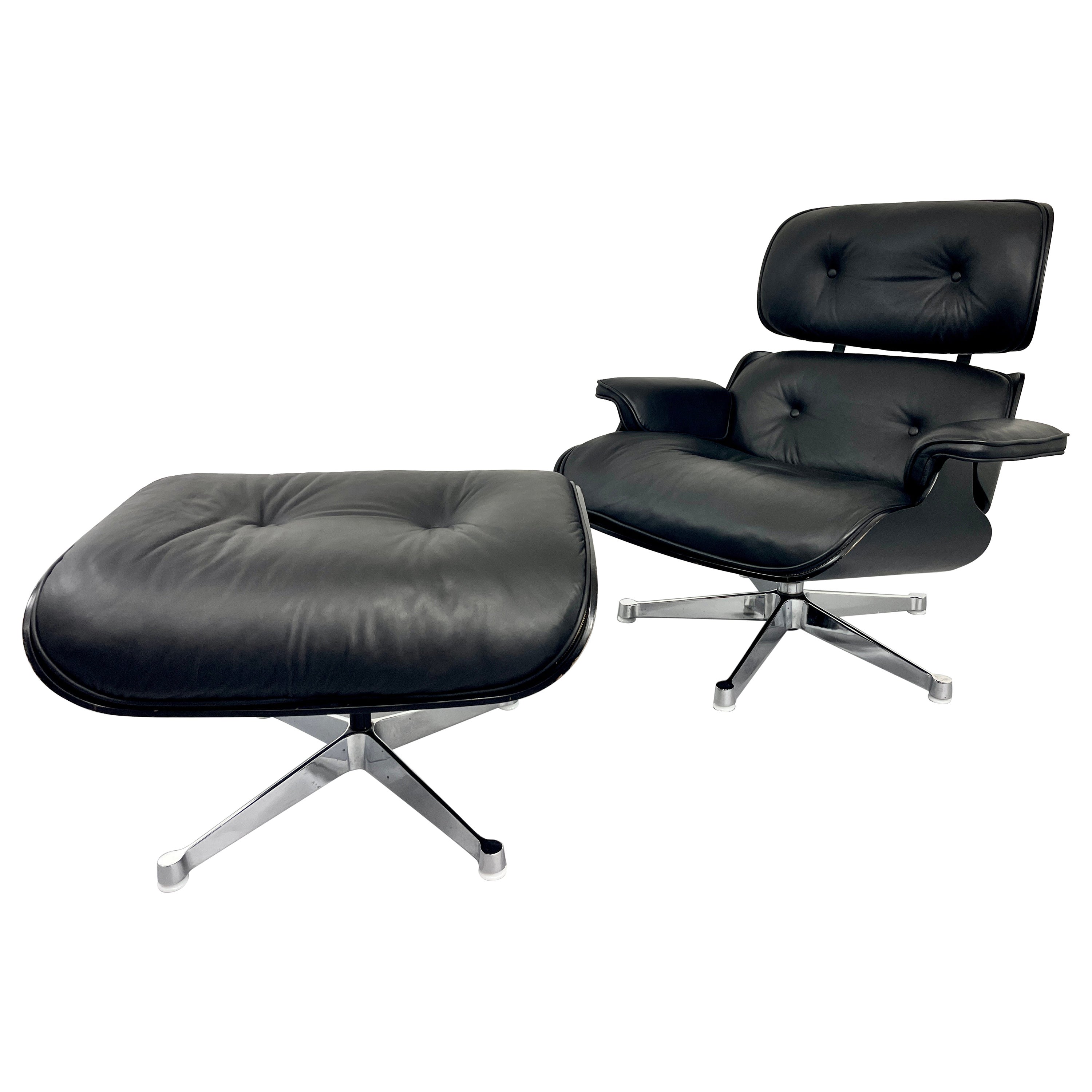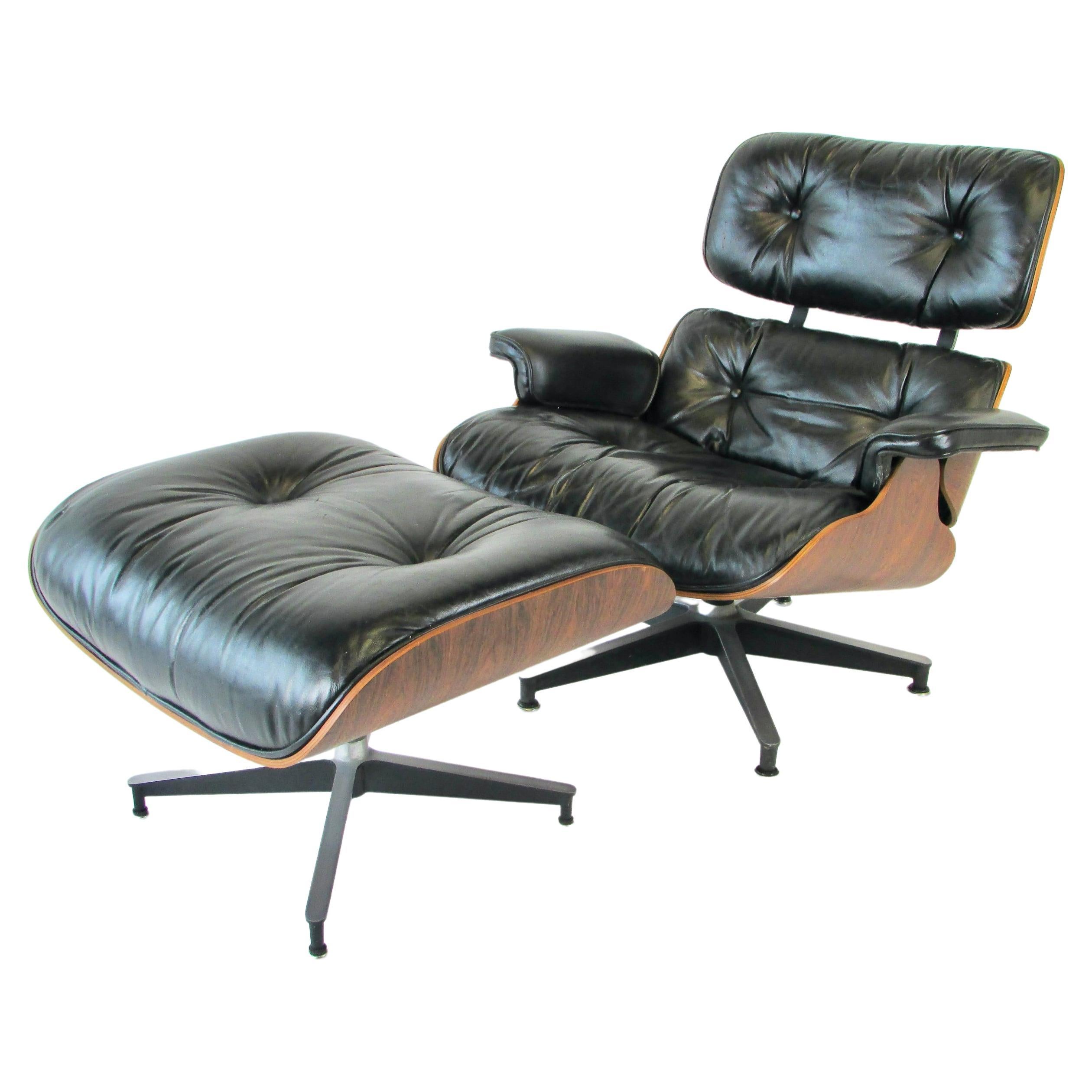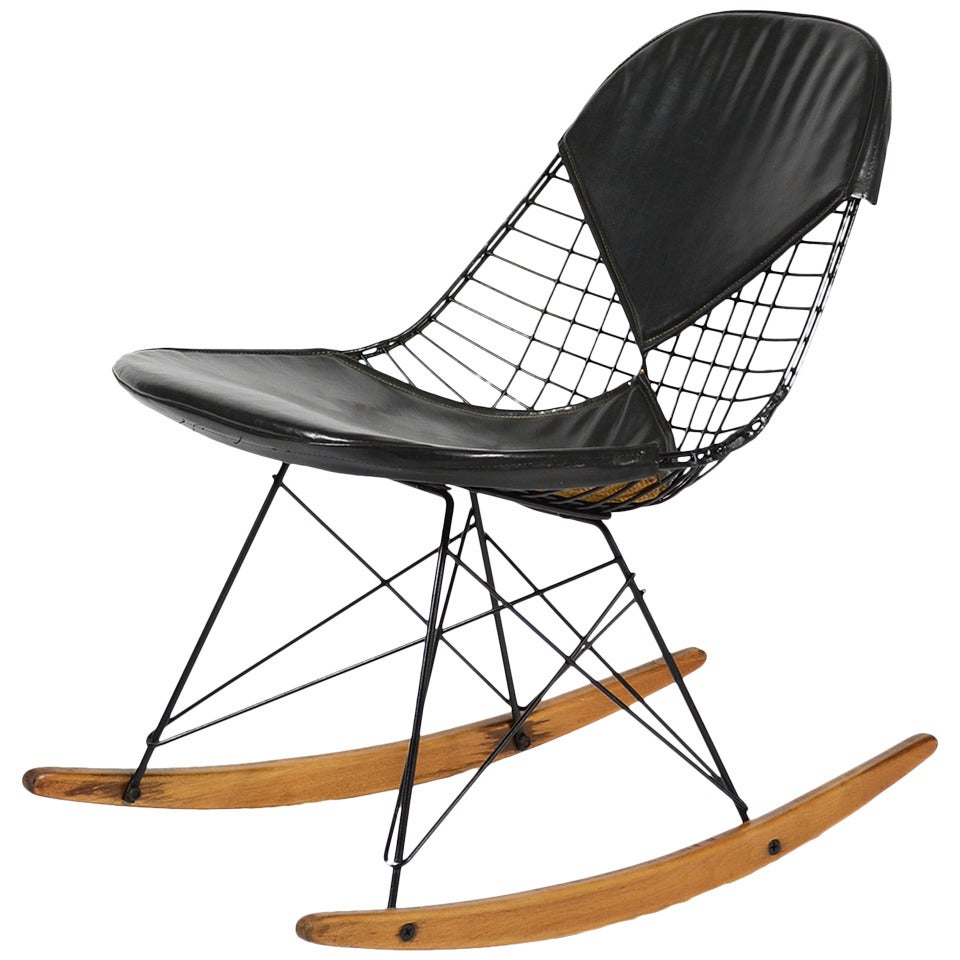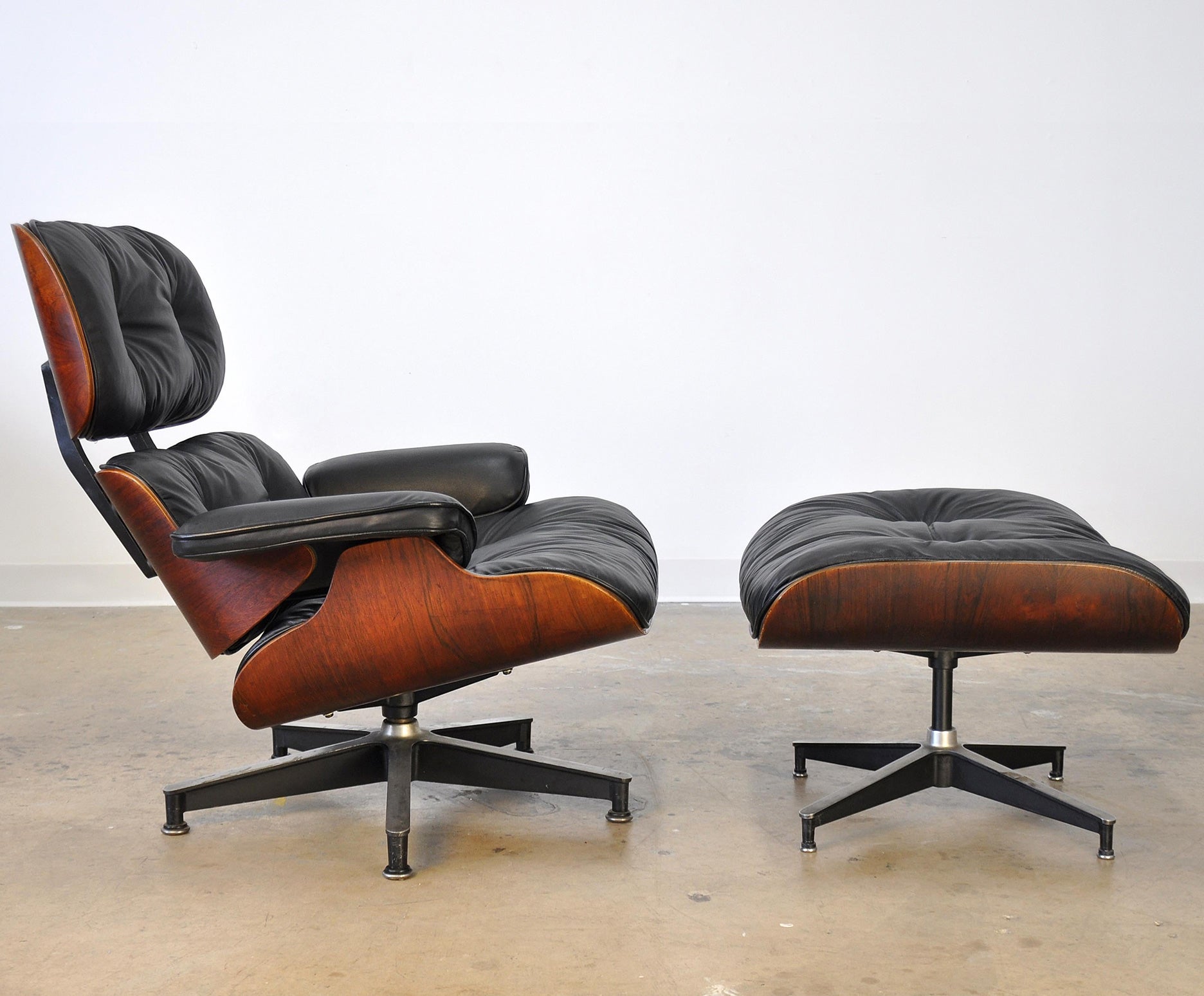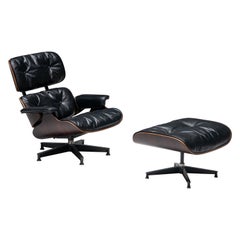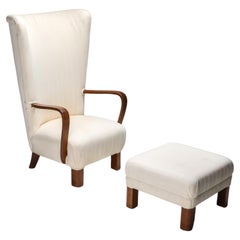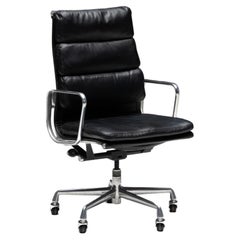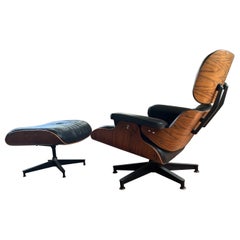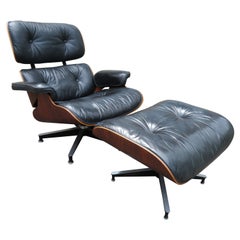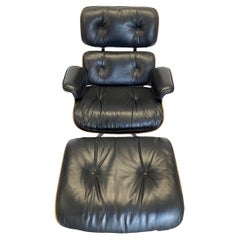Eames Lounge Chair with Ottoman for Herman Miller, 1st Edition 57-59, Iconic
View Similar Items
Eames Lounge Chair with Ottoman for Herman Miller, 1st Edition 57-59, Iconic
About the Item
- Creator:Charles and Ray Eames (Designer),Herman Miller (Manufacturer)
- Design:
- Dimensions:Height: 32.29 in (82 cm)Width: 33.86 in (86 cm)Depth: 31.5 in (80 cm)Seat Height: 15.75 in (40 cm)
- Sold As:Set of 2
- Style:Mid-Century Modern (Of the Period)
- Materials and Techniques:
- Place of Origin:
- Period:
- Date of Manufacture:1957
- Condition:Wear consistent with age and use. Minor fading. Incredible condition for a 1st edition from the 1950s. The charismatic patina contributes to the history of this collector's item.
- Seller Location:Antwerp, BE
- Reference Number:1stDibs: LU933426015752
Eames Lounge Chair and Ottoman
Long before it was the pièce de résistance in a collector’s office or an upscale bachelor pad — landing in ample design magazines, on television and in well-appointed offices over the years — the Eames lounge chair was a fresh, subversive new take on a classic club chair and a culmination of experimentation by its inventive creators.
Charles and Ray Eames (1907–78; 1912–88) met while studying at the Cranbrook Academy of Art, the prestigious Michigan institution that drew such illustrious design minds as Florence Knoll, Eero Saarinen and more. After graduation, they formed the Eames Office, where they spent much time exploring and formulating new techniques in bent plywood and fiberglass with the goal of producing affordable furniture for a mass market. The Eames lounger, on the other hand — with its signature wood-grain back and sumptuous (usually black) leather seat — was different.
While the couple’s DCW chairs, introduced in the 1940s, prioritized ease of production and affordability of materials, the lounge, which debuted in 1956, was Charles and Ray’s interpretation of luxury furniture. And to the Eameses, luxury meant, above all, comfort. The couple famously called the lounge chair and ottoman “a special refuge from the strains of modern living” and described their design as having the “warm receptive look of a well-used first baseman’s mitt.”
Although the seat makes use of the same bentwood technique the Eameses pioneered using their famous “Kazam! Machine” (a handmade apparatus for molding plywood) for their DCW chairs, it tops off this frame with supple leather over a plump, upholstered shape.
Ever fascinated by ergonomics, the Eameses carefully calibrated the pitch of the seat. It has enough flexibility for comfort but not so much that stability is sacrificed. This precise shape comes by way of three connected plywood pieces, which, on early models were covered in five layers of Brazilian rosewood; owing to an early 1990s-era embargo on the material, however, the Brazilian rosewood has since been replaced with either ash, walnut or palisander. The accompanying ottoman is the icing on the comfort cake, inviting the sitter to quite literally kick back and relax.
Today, imitations of the Eames lounge chair and ottoman abound. The seat is currently manufactured by both Herman Miller and Vitra, and when it was launched initially by the former, the supporting marketing blitz emphasized the chair’s versatility — an effort that, given the seat’s current ubiquitousness, was clearly successful.
Charles and Ray Eames
Charles Eames and Ray Eames were the embodiment of the inventiveness, energy and optimism at the heart of mid-century modern American design, and have been recognized as the most influential designers of the 20th century.
As furniture designers, filmmakers, artists, textile and graphic designers and even toy and puzzle makers, the Eameses were a visionary and effective force for the notion that design should be an agent of positive change. They are the happy, ever-curious, ever-adventurous faces of modernism.
Charles (1907–78) studied architecture and industrial design. Ray (née Beatrice Alexandra Kaiser, 1912–88) was an artist, who studied under the Abstract Expressionist painter Hans Hofmann. They met in 1940 at the Cranbrook Academy of Art in suburban Detroit (the legendary institution where Charles also met his frequent collaborator Eero Saarinen and the artist and designer Harry Bertoia) and married the next year.
His technical skills and her artistic flair were wonderfully complementary. They moved to Los Angeles in 1941, where Charles worked on set design for MGM. In the evenings at their apartment, they experimented with molded plywood using a handmade heat-and-pressurization device they called the “Kazam!” machine. The next year, they won a contract from the U.S. Navy for lightweight plywood leg splints for wounded servicemen — they are coveted collectibles today; more so those that Ray used to make sculptures.
The Navy contract allowed Charles to open a professional studio, and the attention-grabbing plywood furniture the firm produced prompted George Nelson, the director of design of the furniture-maker Herman Miller Inc., to enlist Charles and (by association, if not by contract) Ray in 1946. Some of the first Eames items to emerge from Herman Miller are now classics: the LCW, or Lounge Chair Wood, and the DCM, or Dining Chair Metal, supported by tubular steel.
The Eameses eagerly embraced new technology and materials, and one of their peculiar talents was to imbue their supremely modern design with references to folk traditions. Their Wire chair group of the 1950s, for example, was inspired by basket weaving techniques. The populist notion of “good design for all” drove their molded fiberglass chair series that same decade, and also produced the organic-form, ever-delightful La Chaise. In 1956 the Eames lounge chair and ottoman appeared — the supremely comfortable plywood-base-and-leather-upholstery creation that will likely live in homes as long as there are people with good taste and sense.
Charles Eames once said, “The role of the designer is that of a very good, thoughtful host anticipating the needs of his guests.” For very good collectors and thoughtful interior designers, a piece of design by the Eameses, the closer produced to original conception the better, is almost de rigueur — for its beauty and comfort, and not least as a tribute to the creative legacy and enduring influence of Charles and Ray Eames.
The collection of original Eames furniture on 1stDibs includes chairs, tables, case pieces and other items.
- Eames Lounge Chair with Ottoman for Herman Miller, United States, 1957By Herman Miller, Charles and Ray EamesLocated in Antwerp, BEEames lounge chair with ottoman, designed by the iconic duo Charles and Ray Eames for Herman Miller. This timeless icon has been carefully restored to its first-generation glory, born March 5, 1957, in the United States. It features the signature 5-ply plywood construction, down-filled cushions, and coveted Rio walnut veneer sourced from the highly sought-after Dalbergia nigra in Brazil, renowned as the most valuable wood in the world. This particular chair was directly acquired in Saint-Louis, Missouri, USA. The restoration process of the veneer included stripping, bleaching, washing, scraping, sanding, and multi-layered oiling. A tension test was conducted on the shock mounts, which proved to be very stable. The rubber components of the vertical supports were replaced. All leather parts were washed, recolored, and nourished. The down filling was fluffed, tufting was reattached, and 2 back panels with zippers were replaced. All hardware underwent electrolytic cleaning and steaming, and the threads of the hardware were purified. All exposed aluminum parts were manually polished, and the bush in sintered bronze was replaced. The result is a breathtaking revival of the Eames lounge chair, with every detail lovingly restored to its original splendor. The Eames lounge chair made its debut on March 14, 1956, on the renowned NBC program 'Home,' hosted by Arlene Francis. Notably, it was the first piece of furniture ever launched on national television and remains the only one to have stayed in continuous production to this day. Designed by Charles and Ray Eames, along with their close friend, the renowned film director Billy Wilder, the chair was envisioned with Wilder in mind. Interestingly, upon its initial presentation to Wilder, he simply fell asleep in the chair. Charles Eames consistently described his vision for the chair as wanting to impart the receptive appearance of a well-used baseball...Category
Antique 1850s American Mid-Century Modern Lounge Chairs
MaterialsLeather, Walnut
- White Wingback Chair With Ottoman, Denmark, 1950sLocated in Antwerp, BEWhite; Fabric; Wingback Chair; Ottoman; Danish Design; 1950s; Walnut; Wood; Scandinavia; Scandinavian Design; Empire; Pouf; Lounge Chair; Upholstery; Stylish 1950s high back lounge...Category
Vintage 1950s Danish Empire Lounge Chairs
MaterialsFabric, Walnut
$1,537 Sale Price20% Off - Soft Pad Office Chair by Charles and Ray Eames for Herman Miller, US, 1960sBy Herman Miller, Charles and Ray EamesLocated in Antwerp, BECharles and Ray Eames softpad office chair, produced by Herman Miller. This distinguished chair, crafted as the original USA edition for Herman Miller, features a sleek black leather...Category
Vintage 1960s American Mid-Century Modern Office Chairs and Desk Chairs
MaterialsChrome
- Saporiti Lounge Chair with Ottoman, 1960sBy John Lautner, SaporitiLocated in Antwerp, BEPostmodern lounge chairs with ottoman, Saporiti, Italy, 1970s The most comfortable easy chair you might ever sit in. Unusual lounge chair who'd fit perfectly with the architectur...Category
Late 20th Century European Post-Modern Lounge Chairs
MaterialsLeather, Wool, Wood
$6,400 / set - Osvaldo Borsani 'Canada' P110 Lounge Chair with Ottoman for Tecno, Italy, 1960sBy Tecno, Osvaldo BorsaniLocated in Antwerp, BEItalian Design; Osvaldo Borsani; Tecno; 1960s; 1965; Italy; Midcentury Modern; Plywood; Lounge chair; Ottoman; P110 Canada lounge chair with Ottoman, an exemplar of design ingenuity by Osvaldo Borsani for Tecno in 1965. This exceptionally comfortable chair boasts a striking curved wooden frame, accentuated by fabric checkered cushions...Category
Vintage 1960s Italian Mid-Century Modern Lounge Chairs
MaterialsFabric, Plywood
- 1970s Belgian Lounge Chair with Ottoman 'Pasha' by DurletBy DurletLocated in Antwerp, BEHeinz Waldmann & Anita Schmidt lounge chair and ottoman for Durlet in 1970, dark chocolate brown leather, Durlet is a luxury leather furniture brand from Belgium, very much like ...Category
Late 20th Century Belgian Post-Modern Lounge Chairs
MaterialsLeather
- Vintage Herman Miller Eames Lounge Chair and OttomanBy Charles and Ray Eames, Herman MillerLocated in San Pedro Garza Garcia, Nuevo LeonClassic rosewood and black leather lounge chair and ottoman, 670 & 671 designed by Charles and Ray Eames by Herman Miller, circa 1969, original ...Category
20th Century American Mid-Century Modern Lounge Chairs
MaterialsAluminum
- Vintage Rosewood Charles Eames 670 Lounge Chair & 671 Ottoman for Herman MillerBy Charles and Ray EamesLocated in Pemberton, NJA very clean example of a vintage modern icon. Charles Eames 670 & 671 Lounge chair and an ottoman produced by Herman Miller. Beautiful striations in...Category
Vintage 1980s American Mid-Century Modern Lounge Chairs
MaterialsLeather, Rosewood
- Herman Miller Eames Lounge Chair and OttomanBy Charles and Ray Eames, Herman MillerLocated in Brooklyn, NYHandsome classic Eames lounge chair and ottoman. Executed in rosewood and black leather. Cast aluminum bases, with adjustable “domes of silence” leveling glides. Extremely comfortabl...Category
Mid-20th Century American Mid-Century Modern Lounge Chairs
MaterialsAluminum
- Charles Eames Aluminum Group Lounge Chair and Ottoman for Herman MillerBy Charles and Ray Eames, Herman MillerLocated in Dallas, TXCharles and Ray Eames 'Aluminum Group' lounge chair model EA124 and ottoman model EA125. This is an early production one-owner example that has been very well ...Category
Mid-20th Century American Mid-Century Modern Lounge Chairs
MaterialsAluminum
- Gorgeous Restored Eames Herman Miller Lounge Chair and OttomanBy Charles and Ray Eames, Herman MillerLocated in Brooklyn, NYSimply stunning restored Eames lounge chair and ottoman by Herman Miller. Spectacular color and grain detail on the outer shells. Wood has been cleaned, oiled, and freshly finished i...Category
Mid-20th Century American Mid-Century Modern Lounge Chairs
MaterialsMetal, Aluminum
- Eames for Herman Miller Rare 1956 First Year Lounge Chair with Spinning OttomanBy Charles and Ray Eames, Herman MillerLocated in Los Angeles, CAA rare 1956 first year production of the iconic 670/671 lounge chair with spinning ottoman by Ray and Charles Eames for Herman Miller. The spinning ottoman was only made during the f...Category
Vintage 1950s American Mid-Century Modern Lounge Chairs
MaterialsLeather, Rosewood
Recently Viewed
View AllRead More
The 21 Most Popular Mid-Century Modern Chairs
You know the designs, now get the stories about how they came to be.
Iconic Furniture Makes This 1958 Midwestern Home a True Mid-Century Gem
Designer Susan Yeley turned to 1stDibs to outfit an Indiana home with standout pieces that complement its modernist style.
